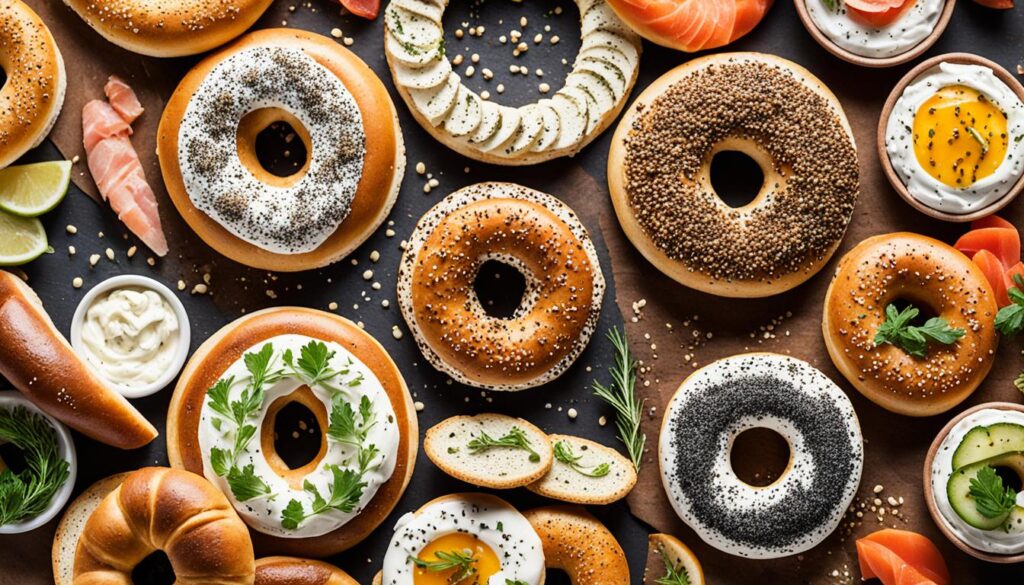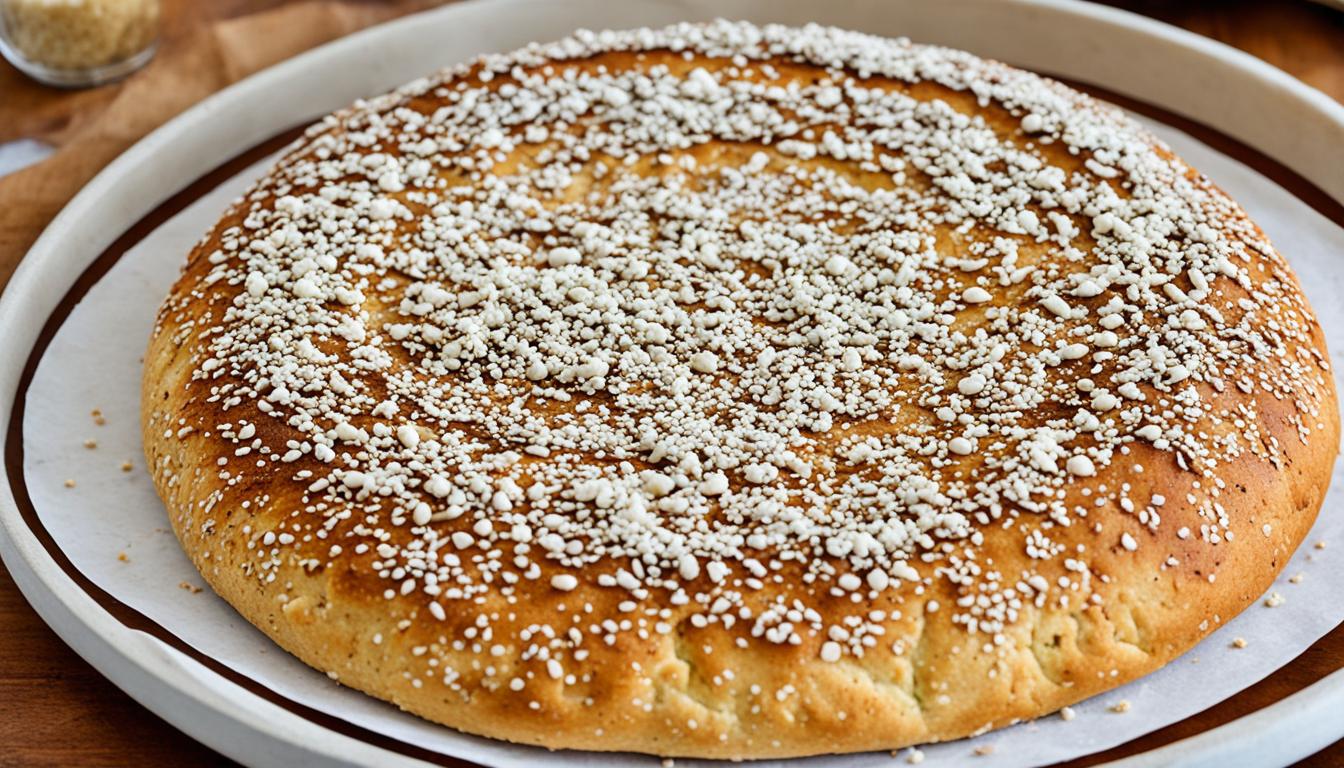Have you ever wondered about the origins of your favorite Middle Eastern bread? Or how it might be connected to a popular breakfast staple like the bagel? Prepare to be amazed as we delve into the fascinating history of kaak, a traditional Arabic bread with ancient roots that may just challenge our beliefs about the origins of the bagel.
The History of Kaak and Bagels
Kaak and bagels both have fascinating histories that trace back to ancient times. Let’s delve into the origins of these beloved breads and explore their cultural significance.
Kaak: Ancient Bread with Arabic Origins
Kaak has a long and storied history that can be traced back to the Middle East. This ring-shaped bread is mentioned in Arabic cookbooks dating back to the 10th and 13th centuries. These ancient texts highlight the cultural and culinary significance of kaak, showcasing its prominence in traditional Arabic cuisine.
The shape and preparation of certain types of kaak, such as the variety that is boiled and then baked, bear a striking resemblance to bagels. This suggests that kaak could have served as a precursor to the iconic bagel we know today.
The Bagel: A Well-Documented History
The history of bagels, particularly their origins in Eastern Europe, is well-documented. However, the possibility of an Arab influence on the development of bagels cannot be ignored.
The Arab conquests in the Mediterranean region, including southern Italy where Bari, the supposed birthplace of the bagel, was located, create a connection between Arab culinary traditions and the bagel. The Arab influence can be seen in the use of wheat flour in bagel recipes, a departure from the dominant use of rye flour in Poland at the time.
While the exact extent of the Arab influence on the bagel’s development requires further research, it’s fascinating to consider the potential role that kaak and Arab culinary traditions may have played in shaping the bagel we enjoy today.
The Cultural Significance
Beyond their historical connections, both kaak and bagels hold cultural significance in their respective regions.
Kaak is deeply rooted in Middle Eastern cuisine and is associated with traditions, flavors, and rituals that have been passed down through generations.
Bagels, on the other hand, have become synonymous with American Jewish cuisine and are often enjoyed as a symbol of heritage and cultural identity.
By exploring the shared history and cultural significance of kaak and bagels, we gain a deeper understanding of the interconnectedness of diverse food cultures and the rich tapestry of culinary traditions that continue to evolve and inspire us.
| Kaak | Bagels |
|---|---|
| Ring-shaped bread | Ring-shaped bread |
| Boiled and baked | Boiled and baked |
| Mentioned in Arabic cookbooks dating back to the 10th and 13th centuries | Origins in Eastern Europe and popularized in America |
| Cultural significance in Middle Eastern cuisine | Symbol of American Jewish heritage |
Table: A comparison of kaak and bagels
Variations of Kaak and Bagels
Kaak and bagels offer a delightful array of regional variations and baking techniques. Let’s explore the diverse flavors and unique characteristics of these beloved breads.
Variations of Kaak
In the Middle East, kaak comes in different forms, each with its own distinct qualities. One of the popular variations is kaak al Quds, which hails from Jerusalem. This special kaak is made by brushing the dough with sugar water, allowing sesame seeds to cling to the exterior. The result is a sweet and nutty flavor that perfectly complements the soft, chewy texture of the bread.
Other variations of kaak include savory options like kaak bil zaatar, featuring a generous sprinkling of thyme and sesame seeds on top, or kaak bil sumac, which incorporates sumac for a tangy twist.
Bagel Variations
Bagels, on the other hand, offer a wide range of flavors and toppings to suit every palate. From classic poppy seed and sesame seed toppings to more adventurous options like garlic or everything bagels, there is a bagel variation for everyone.
While traditional bagels are made with plain dough, creative bakers have expanded the repertoire with flavors such as cinnamon raisin, blueberry, and even chocolate chip. These variations infuse the bagel with a burst of sweetness or a burst of fruitiness, elevating the taste experience.
Baking Techniques
The baking techniques used for both kaak and bagels are crucial in achieving their unique textures and flavors. While there are similarities, it’s important to note the subtle differences in their preparation.
Kaak is commonly boiled before baking, giving it its signature density while retaining a soft and chewy interior. On the other hand, bagels are typically boiled first and then baked, resulting in a slightly denser texture compared to traditional breads.
The boiling process gives both kaak and bagels their distinctive crusts, adding a pleasing chewiness and contributing to their longevity as shelf-stable breads.
A Visual Comparison
Let’s take a closer look at the variations of kaak and bagels in this detailed comparison table:
| Kaak | Bagels |
|---|---|
| Popular Variations | Classic Variations |
| Kaak al Quds (sesame-coated) | Plain Bagel |
| Kaak bil zaatar (topped with thyme and sesame) | Poppy Seed Bagel |
| Kaak bil sumac (sumac-infused) | Sesame Seed Bagel |
| Baking Techniques | Texture |
| Boiled, then baked | Dense and chewy |
| Boiled, then baked | Slightly denser than traditional bread |
As you can see, both kaak and bagels offer a delightful range of variations and baking techniques, allowing for endless possibilities and personal preferences.

Culinary Fusion and Cultural Exchange
The similarities and connections between kaak and bagels demonstrate the culinary fusion that occurs with cultural exchange and the evolution of recipes. Kaak has a long-standing cultural significance in the Middle East and is associated with the traditions and flavors of the region. The introduction of the bagel, influenced by Arab culinary traditions, further exemplifies the interconnectedness of different food cultures and the way they evolve and adapt over time. The evolution of kaak and bagels showcases the rich history and symbolism embedded in these ancient breads, and the importance of recognizing and preserving their origins.
Throughout history, food has been a powerful medium of cultural exchange. As cultures interacted and intersected, ingredients, techniques, and even entire recipes were borrowed, adapted, and transformed. The story of kaak and bagels is a perfect example of this culinary fusion that occurs when diverse cultures meet and exchange ideas.
“Food is symbolic of love when words are inadequate.”
– Alan D. Wolfelt
Kaak and bagels are not merely breads; they carry immense cultural significance and symbolism. Their preparation and consumption are steeped in tradition and reflect the values and identity of the communities that have cherished them for centuries.
The ancient kaak bread, with its circular shape, represents unity and wholeness. It is often shared during gatherings and celebrations, symbolizing friendship and communal bonds. Similarly, the bagel’s round shape is said to signify eternal life and the cyclical nature of existence. These symbolic meanings reflect the profound connections between food, culture, and spirituality.
The infusion of Arab culinary traditions into the bagel is a testament to the cultural exchange that has shaped our culinary landscape. As Arab traders and conquerors traveled through different regions, they brought with them their unique flavors and cooking techniques. Over time, these culinary influences merged with local ingredients and traditions, resulting in the creation of new and exciting dishes like the bagel.
To further illustrate the cultural exchange, let’s take a closer look at the origins of the ancient kaak bread:
| Ancient Kaak Bread | Cultural Significance |
|---|---|
| Ancient Arabic Cookbooks | Depicted kaak as a staple of Arabic cuisine |
| Kitab al Tabikh | A 10th-century cookbook that referenced kaak |
| Kitab al Wusla ila al Habib | A 13th-century cookbook that highlighted various varieties of kaak |
This historical evidence showcases the long-standing cultural significance of kaak and its influence on the culinary traditions of the Middle East. The introduction of kaak into Eastern Europe, and its subsequent evolution into the bagel, is a testament to the enduring impact of cultural exchange.
The symbolism behind kaak and its cultural significance speaks volumes about the power of food to connect people and bridge cultural gaps. By understanding and appreciating the origins of these ancient breads, we can celebrate the diversity of our global food heritage and foster a deeper appreciation for the culinary traditions that have shaped our collective culinary identity.
Conclusion
The ancient kaak bread, originating from Arabic traditions, holds a special place in Middle Eastern cuisine. Its rich history and connection to the bagel emphasize the fascinating cross-cultural interactions and culinary fusion that have shaped our food traditions over time.
While the bagel has its own unique story within American Jewish cuisine, recognizing its Arab origins enhances our understanding and appreciation of the interwoven nature of diverse cultures and their culinary traditions. By acknowledging the inspiration behind the bagel, we not only honor the contributions of Arab cuisine but also promote a broader awareness of food history and cultural exchange.
Whether you indulge in a traditional kaak or savor a delicious bagel, these breads symbolize the shared heritage and interconnectedness of different food cultures. They remind us of how our culinary traditions have evolved and transformed, reflecting the influence and fusion of diverse cultures throughout history.
